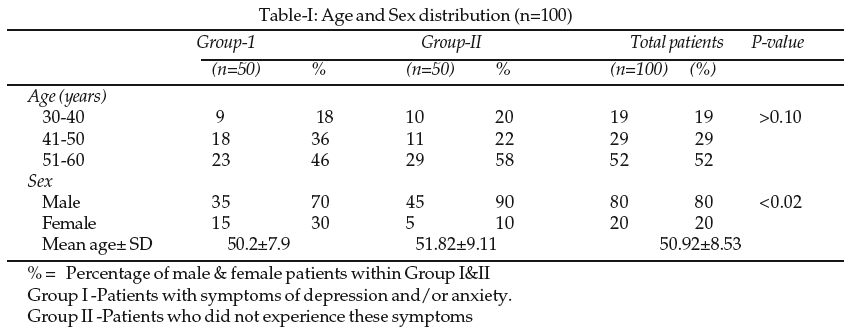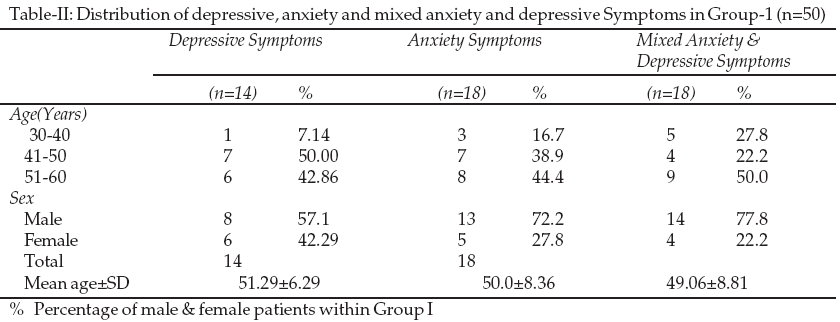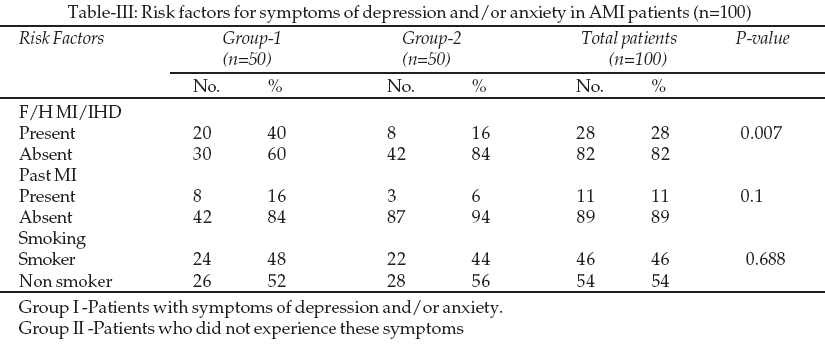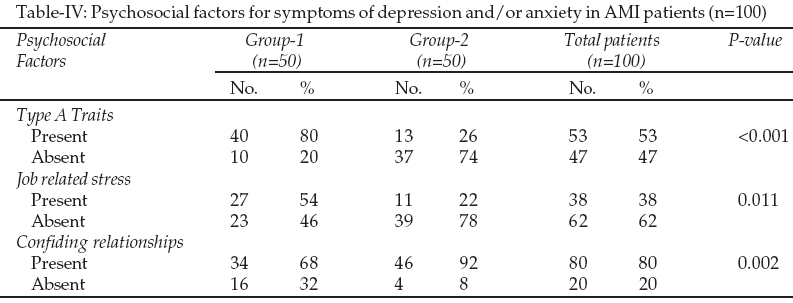|
||||
|
Published by : PROFESSIONAL MEDICAL PUBLICATIONS |
||||
|
ISSN 1681-715X |
||||
|
||||
|
- |
||||
|
ORIGINAL ARTICLE |
||||
|
- |
||||
|
Volume 24 |
April - June 2008 (Part-II) |
Number 3 |
||
|
|
||||
|
|
||||
|
||||
|
Published by : PROFESSIONAL MEDICAL PUBLICATIONS |
||||
|
ISSN 1681-715X |
||||
|
||||
|
- |
||||
|
ORIGINAL ARTICLE |
||||
|
- |
||||
|
Volume 24 |
April - June 2008 (Part-II) |
Number 3 |
||
|
|
||||
|
|
||||
Psychosocial factors associated with symptoms
of depression and anxiety following
Acute Myocardial Infarction
ABSTRACT
Objective: To study factors associated with symptoms of depression and/or anxiety following acute myocardial infarction (AMI)
Methodology: This Cross-sectional analytical, non-interventional, hospital based study was carried out at Punjab Institute of Cardiology (P.I.C) and Services Hospital, Lahore. One hundred consecutive inpatients with AMI diagnosed using WHO criteria, with the age range of 30-60 years (who were without physical complications) were included in the study. The Urdu version of Hospital Anxiety and Depression Scale (HADS) was administered to each patient during the period of 5-7 days following AMI. A semi structured clinical interview was also conducted which included demographic information, psychiatric assessment and risk factors related to AMI especially psychosocial factors. Results were analyzed using Statistical Package for Social Sciences (SPSS).
Results: Out of 100 subjects, 80 (80%) were males and 20 (20%) were females. The age range was between 30-60 years (50.92±8.53). Over all, symptoms of depression and/or anxiety were found in 50 (50%) patients. More particularly, symptoms of depression were found in 14%, symptoms of anxiety in 18%, and mixed symptoms (depression and anxiety) in 18% of the patients. A significant association was found between symptoms of depression and/or anxiety following AMI and family history of AMI (p <.007), type A behavior traits (p <.001), job stress (p <.01) and lack of confiding relationships (p <.002). However, no significant association was found between symptoms of depression and/or anxiety following AMI and past history of AMI.
Conclusions: The findings highlight the critical need to assess symptoms of depression and/or anxiety following AMI along with the factors leading to these. This would be particularly important in patients who have a family history of MI, job related stress, lack of confiding relationships and type A behavior traits.
KEY WORDS: Depression, Anxiety, Symptoms, Psychosocial factors, Post Myocardial Infarction.
Pak J Med Sci April - June 2008 (Part-I) Vol. 24 No. 2 192-197
1. Dr. Muhammad Saleem Akhtar, DPM, MCPS, FCPS.
Assistant Professor, Department of Psychiatry,
2. Prof. Dr. Saàd Bashir Malik, DPM, FRC Psych.
Head of Department of Psychiatry,
1-2: Allama Iqbal Medical College,
Lahore.
3. Ms. Masha Asad Khan, Mphil, MSc.
Lecturer, Psychology,
Kinnaird College for Women,
Lahore – Pakistan.
Correspondence:
Dr. Muhammad Saleem Akhtar,
The Parklane Clinic, 31-L/A, Gulberg II, Lahore.
E-mail: msakhtar65@hotmail.com
* Received for publication: November 28, 2007
* Revision Received: February 21, 2008
* Revision Accepted: February 22, 2008
INTRODUCTION
Acute Myocardial Infarction (AMI) is one of the most widespread life threatening diseases in industrialized countries. In USA alone, about 1.5 million patients annually suffer from AMI (about one patient every 20 second).
1 Incidence of AMI is reported to be on the rise in South Asian countries including Pakistan2 and is estimated to be as high as in European population.3WHO report 2001 suggests that ischemic heart disease (IHD) and depression would be the two leading causes (first and second respectively) of global burden of diseases on economies of the world in the year 2020.
4There are studies which reveal that depression and anxiety states represent a high co-morbidity with AMI.
5-8 It is estimated that one in six people will experience an episode of major depression at least once in their life, the number rises to one in two in people with heart disease.9Life time prevalence rate of depression is 18-20% in patients with AMI.10 Lloyed and Cawley11 reported that approximately two-third of the patients with AMI had anxiety and depressive states. The occurrence of depression and anxiety after AMI not only influence the prognosis of AMI but their existence before the AMI also act as a risk factor10-13 Depression not only impair health related quality of life14 but also increases risk of incident cardiac events even after controlling for other cardiovascular risks.15 Patients of AMI who develop depression are six times more likely than others to die within six months of AMI,16 leading to 8-fold increase in death rates at 18 months.17The findings from literature reveal factors that have been associated with depression and anxiety following AMI. These include a past history of IHD
1,18 and psychosocial factors viz type A behavior pattern,18,19 job stress20 and lack of social support etc.21Our previous work
8 has shown that 50% of the patients suffering from AMI experience symptoms of depression and/or anxiety. Although studies5,7 investigating the occurrence of depression and /or anxiety had been conducted in Pakistani population, we are unaware of any work which studied the relationship of these symptoms with psychosocial factors in local setting.The present study was conducted to explore the association between symptoms of depression and/or anxiety following AMI and psychosocial factors in the environment This knowledge would help in the better management and prevention of these symptoms associated with AMI.
PATIENTS AND METHODS
This cross sectional analytical study was conducted in the Punjab Institute of Cardiology (PIC) and Services Hospital, Lahore. One hundred consecutive inpatients with AMI diagnosed by a consultant cardiologist using WHO criteria,
23 both male and female, with the age range of 30-60 years (who were without physical complications), were included in the study. Patients with medical problems other than AMI, substance abuse and past history of psychiatric illness were excluded from the study. After taking written informed consent from each participant validated Urdu version of Hospital Anxiety and Depression Scale (HADS)24 was administered to assess the symptoms of depression and/or anxiety. This scale has been designed to identify these symptoms in patients with medical disorders. The internal consistency of HADS for anxiety items ranged from 0.41-0.76 and for depression items it ranged from 0.30-60. The validity for depression items was 0.70 and 0.74 for anxiety items. A semi- structured clinical interview was also conducted which included demographic details, psychiatric assessment, information regarding the risk factors related to AMI particularly psychosocial factors namely Type ‘A’ behavior traits, job stress, social support and confiding relationships etc. Type ‘A’ behavior traits were assessed by using Ladwig et al.,18 criteria which included various aspects like hostility aggressiveness, anger, competitive drive and time urgency etc. The social support and lack of confiding relationship were assessed by using Social Support Questoinnare.25 which intends to quantify the availability of and satisfaction with, social support. The patients were interviewed on 5-7 days following AMI. Each patient was interviewed for about 30-45 minutes on his/her bedside ensuring privacy. The attendants of patients were also interviewed when necessary. A computerized statistical analysis of the data was done using SPSS (10.0 version). The comparison was done by using Chi-Square for categorical variables.RESULTS
Among 100 patients, 80 (80%) males and 20 (20%) females with the age range of 30-60 years (50.92±8.53 years) following AMI were studied. The result of the total sample was divided into 2 groups (Table-I): Group I (n=50) included those patients who were experiencing symptoms of depression and/or anxiety. It included patients suffering from symptoms of depression (14%), anxiety (18%), or mixed anxiety and depression (18%) respectively. However, group II (n=50) included those patients who did not experience these symptoms. Table-II shows the distribution of Depression, anxiety and mixed anxiety and depressive symptoms in Group-1.

Results revealed a significant association between age (above 45 years i.e.46-60 years), female sex (p <0.02) and symptoms of depression and/or anxiety following AMI as shown in Table-I.

A significant association was found between family history of AMI/ ischemic heart disease (p <.007) and symptoms of depression and/or anxiety following AMI. However no significant association was observed with past history of MI and smoking (Table-III).

The analysis of psychosocial risk factors revealed a significant association between type A behavior traits (p <.001) and the symptoms of depression and/or anxiety in post AMI patients. Whereas of the total sample (n= 100) 53 patients (53%) reported type A behavior traits, these traits were reported in 40 patients (80%) of group I (n= 50) (Table-IV). Job related stress (p<.01) and lack of confiding relationships (p<.002) were also found to be significantly associated with symptoms of depression and/or anxiety in post AMI patients (Table-IV).

DISCUSSION
Findings of this study show symptoms of depression and/or anxiety in 50% of the post AMI patients. Various factors have been highlighted which are associated with development of symptoms of depression and/or anxiety following AMI .These are both physical and psychosocial ones.
18-22The present study revealed no significant association between past history of AMI (p <0.1) and symptoms of depression and/or anxiety following AMI. This finding is in unison with those of previous studies.
18 A possible reason for this negative association could be that prior experience of AMI may result in enhanced coping skills to deal with subsequent illness of the same nature. This may manifest as reduction in experience of these symptoms after AMI.In the present study family history of IHD/MI was found significantly (p <.007) associated with the symptoms of depression and/or anxiety in post AMI patients. A possible explanation for this association, in the present study, may be that these subjects have been sensitized by the experience of observing the same illness in their relatives along with its likely complications including long term disability and death the close knit family ties in our socio-cultural setting may further contribute to this effect
In the current study Type A behavior traits were found significantly associated (p <.001) with symptoms of depression and/or anxiety following AMI (Table-III) and this has also been supported by previous studies
26,27 Fukunshi and Hattori19 studying Japanese subjects found type A behavior traits to be a predictor of depression following AMI. Type A individuals are well known for their competitive, ambitious and fast pace of life and it is likely that the forced period of compulsory bed rest following AMI is incompatible with their habitual life style and promotes further stress, which can present symptoms of depression and anxiety after AMI. Further as a consequence of their personality traits, these individuals are more likely to worry excessively about likely complications of AMI, uncertainties about the future etc and thereby become more prone to symptoms of depression and anxiety after AMI.A significant association (p <.01) was found between job stress and symptoms of depression and anxiety following AMI. Ladwig et al
18 also described the positive relationship between job stress and depression in these patients A possible explanation may be that the subjects reporting job stress may be already burdened with extra stress at work and the occurrence of AMI brings about an extra burden. This finding has an important implication in that the patients who work in high stress environment are not only likely to develop AMI27,28 but also symptoms of depression and /or anxiety in post AMI period,18 which further impair their ability to cope with stress. This aspect merits special consideration when planning for rehabilitation of such patients.Lack of confiding relationships and symptoms of depression and/or anxiety after AMI were found to be significantly associated (p<.002) in the current study (Table-IV). This finding is also supported by other studies.
5,27-29 The possible reasons for the lack of confiding relationships, may be, change in our socio-cultural setup, forced marriages, lack of trust, insecurity, break down of joint family system etc. Some studies30,31 report that loneliness and lack of social support are not only identified as predictor of premature death after AMI but also associated with symptoms of depression and anxiety in post MI period.22,32Limitations of the study: We acknowledge that our study has a number of limitations. Firstly, the present study is based on sample restricted to particular hospital and the patients only with AMI were included who were not suffering from accompanying medical, cardiovascular and psychiatric diseases, therefore findings cannot be generalized. Secondly, the patients were assessed only once after interval of 5-7 days following AMI therefore it is difficult to determine whether these symptoms were short lived or long lasting. Thirdly, the relationship of symptoms of depression and /or anxiety with Psychosocial factors viz. job stress, lack of confiding relationship and type A behavior traits were assessed by using semi structure interviews. No specific standardized and valid instruments were used to assess these factors. We suggest that further studies be carried out using larger sample size, recruiting patients from different hospitals and using specific standardized, valid instruments to measure above mentioned psychosocial factors.
CONCLUSIONS
Our findings highlight a number of psychosocial factors associated with symptoms of depression and /or anxiety in post AMI patients. These include family history of AMI, type A behavior traits, job stress and lack of confiding relationships. Medical teams dealing with patients suffering from AMI need to be aware of these factors in order to assess and manage these patients in a more holistic way. Our work also underscores the importance of preventive mental health in these patients which can be promoted by introducing psycho-educational programs viz Stress management techniques, life style management strategies etc. This would not only assist in a more comprehensive management of AMI but is also likely to reduce the chances of these patients suffering from symptoms of depression and/or anxiety in post MI period which carry additional burden.
REFERENCES
1. Lawrence TM, Stephen MJ, Maxine PA, (eds.) Heart: current medical diagnosis and treatment 2000. 39th ed. New York: Lange Medical Books \ McGraw -Hill, 2000;351-443.
2. Yousaf, Ordnpuce S, Anand S .The global burden of cardiovascular disease: a review of evidence In: SethiKK (edi). Coronary artery disease in Indians: A global perspective. Mumbai: Cardiol Soc India 1998;11-20.
3. Memon MA, Samad A. Acute myocardial infarction in women: prospective study from a developing country. Pak J Cardiol 1999;10:95-107.
4. World Health Organization. Mental heath: newunderstanding, new hope. WHO report 2001;Geneva: WHO;2001.
5. Khan KH. Psychiatric morbidity in myocardial infarction patients (Dissertation), Karachi: CPSP 1994.
6. Frassure SN. In symptoms of psychological stress as predictors of long-term outcome after acute myocardial infarction in men. Am J Cardiol 1991;67:121-7.
7. Raza -ur -Rehman. Depressive disorder in patients with recent myocardial infarction (Dissertation), Karachi: CPSP 1999.
8. Akhtar MS, Malik SB, Ahmad MM. Symptoms of depression and anxiety in post myocardial Infarction patients. J Coll Physician Surgeon Pak 2004;14:615-18.
9. World Federation for Mental Health–www.wmhdday.net
10. Cleophas TJM. Depression and myocardial infarction implications for medical prognosis and option for treatment. The Netherlands J Med 1998;52:82-9.
11. Lloyed GG, Cawley RH. Distress or Illness: A study of psychological symptoms after myocardial infarction. Br J Psychiatry 1983;142:120-5.
12. Lesperance F, Frassure Smith N, Talajic M. Major depression before and after myocardial infarction, its nature and consequences. Psychosom Med 1996;58:99-110.
13. Farooq S, Ahmad B. Depression and coronary artery disease-real heart break. J Coll Physician Surgeon Pak 2001;11:263-71.
14. Dickens CM, McGowan, Percival C, Tomenson B, Cotter L, Heagerty A, et al. Contribution of depression and anxiety to impaired health related quality of life following first myocardial infarction. Br J Psychiatry 2006;189:367-72.
15. Rugulies R. Depression as a predictor of coronary heart disease: A systematic review and met analysis of the literature. Am J Preventive Med 2003;23:51-61.
16. Sobel. DS. Hostility, Depression and heart disease" in Health World online at www.healthy.net
17. Barefoot JC, Helms MJ, Mark DB. Depression and long-term mortality risk in patients with coronary artery disease. Am J Cardiol 1996;78:613-17.
18. Ladwig KH, Lermacher W, Roth R, Breithord G, Budde T, Borggrafe M. Factors which provke post infarction depression, results from post infarction late potential study (PILP). J Psychosom Res 1992;36:723-29.
19. Fukunishi I, Hattori M. Mood states and type A behaviour in Japanese male patients with myocardial infarction. Psychother Psychosom 1997;66:314-18.
20. Kleiokot. In: Davison CG, Neale MJ, (eds.). Psychophysiological disorder and health psychology: Abnormal psychology. 7th ed. New York: John Willey and Sons Inc 1997;178-205.
21. Hamalain H, Smith R, Pukka P, Lind J, Kallio U, Kuttcler K, et al. Social support and physical and psychological recovery one year after MI or coronary artery byepass surgery. Scand J Pub Health 2000;28:62-70.
22. Ornish, Dean. Love and Survival: The Scientific basis for the healing power of intimacy. Harper-Collins. In World Federation for Mental Health, www.wmhday.net
23. World Health Organization (WHO). The prodromal symptoms of myocardial infarction and sudden death. Copenhagon: WHO 1971.
24. Mumford DM, Tareen IAK, Bajwa MAZ, Bhatti MR, Kareem R. The translation and evaluation of an Urdu version of hospital anxiety and depression scale. Acta Psych Scand 1991;83:81-8.
25. Sarason IG, Levine HM, Basham RB, Sarason BR. Assessing social support: The Social Support Questionnaire.J Pres Soc Psychol 1983:44:127-9.
26. Chesney MA, Eagleston JR, Rosenman RH. Type A structured interview: A behavioral assessment. J Behavior Assessment 1980;2:255-72.
27. Labbrozzi D, Carince F, Nicolucci A, Bettmordi O, Zotti AM, Tognoni G. Psychological characteristics of patients with infarction, results of the Gissi –2 Italian group for the study of survival in myocardial infarction. G Ital Cardiol 1996;26:85-106.
28. Aroma A, Raitasalo R, Reunanen A, Impivaarao, Heliovaara M, Kenlt P. Depression and cardiovascular diseases. Acta Psych Scand 1994;377:77-82.
29. Frassure SN, Lesperance F, Talagic M. Depression following MI impact on 6-month survival. JAMA 1993;15:1819-25.
30. Miller TQ, Markides KS, Chiriboga DA, Ray LA. A test of psychosocial and health behaviour: models of hostility. Results from a 11 year follow up of Maxicans Americans. Psychosom Med 1995;57:572-81.
31. Frassure SN, Lesperance F, Juneacc M, Talagic M, Bourassa MG. Gender Depression and one year follow up: Prognosis after MI. Psychosom Med 1999;61:26-37.
32. News Channels, Heart disease and depression: Health Watch. Chattanooger TN. Available from www.newschannel 9.com/heathwatch/hw292.html
HOME | SEARCH | CURRENT ISSUE | PAST ISSUES
Professional
Medical Publications
Room No. 522, 5th Floor, Panorama Centre
Building No. 2, P.O. Box 8766, Saddar, Karachi - Pakistan.
Phones : 5688791, 5689285 Fax : 5689860
pjms@pjms.com.pk